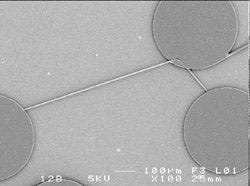November 7, 2012
|
Pristine silk fiber integrated into a photonic chip. The fiber connects three light-holding disks. When light is injected into one of the disks, it propagates along the silk to the other two. (Image courtesy of Nolwenn Huby) |
Research conducted by scientists at Tufts University (Boston) and the CNRS Institut de Physiques de Rennes (France) demonstrates that natural silk could be used to manipulate light. The Tufts team is using the information they have gathered to create proteins that rely on silk's optical properties for implantable sensors, while the Rennes team is using pristine, natural spider silk to guide light through photonic chips. This work could eventually lead to the development of silk-based biosensors and implantable medical imaging devices.
Silk is famous for being one of the strongest fibers in nature, in addition to being biocompatible, biodegradable, and durable. However, the material has also been found to be a manipulator of light, which can travel through silk almost as easily as it flows through glass fibers.
Led by biomedical engineer Fiorenzo Omenetto, the Tufts group is developing silk-based materials that look like plastic but retain the optical properties of pristine silk. His team is exploring the possibilities of using silk to integrate a technological component with living tissue. "We're thinking of how to scale up [production], how to interface with current technology," Omenetto says. He hopes some of the more 'gadget-like' fruits of his labor will be commercially available within the next five to 10 years.
As a light guide, silk works in a way comparable to glass microfibers that carry light within a chip. However, spiders produce silk that is ready to use, while glass microfibers have to be heated to high levels and carefully sculpted. Led by physicist Nolwenn Huby, the Rennes team integrates silk into circuits. By integrating real spider silk into a microchip, the researchers have found that the material is able not only to propagate light but also to direct, or couple, light to selected parts of the chip. Huby hopes that this work can be used to create biosensors that can detect the presence of a molecule or the activity of a protein.
As a result of its research, Huby's team hopes to develop devices for use by biologists and medical professionals. In addition to serving as a component in biosensors, spider silk could also provide a light source for taking pictures inside the body. Because of its great strength, natural silk might be able to convey light into the body through a very small opening, providing a less-invasive way to perform spectroscopy-based imaging or chemical diagnoses.
About the Author(s)
You May Also Like



